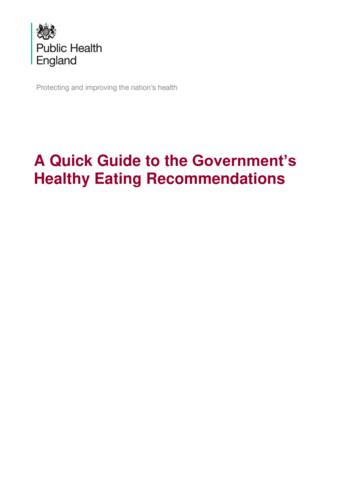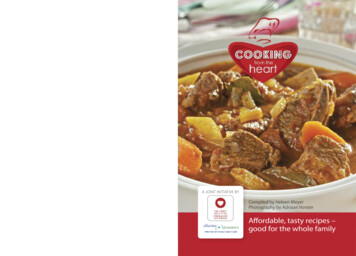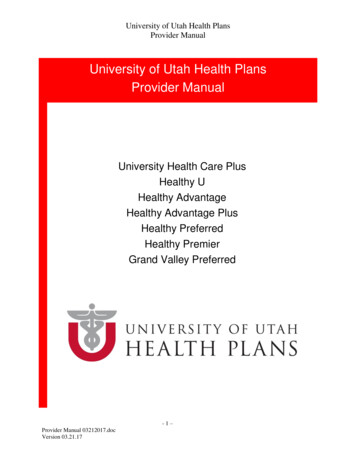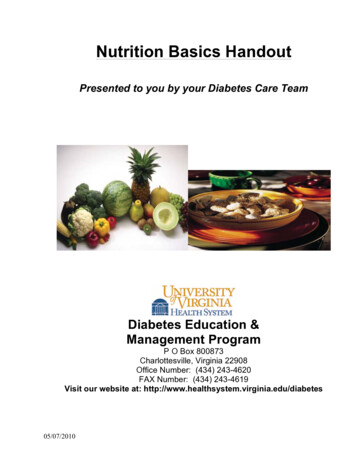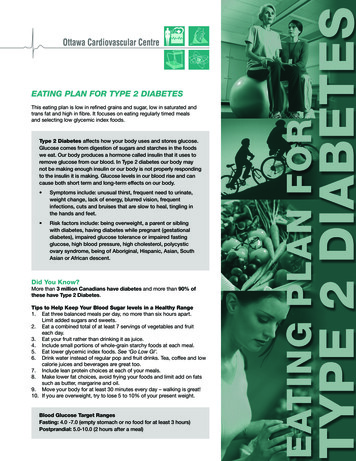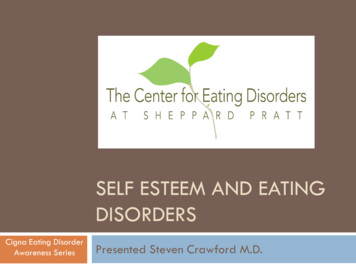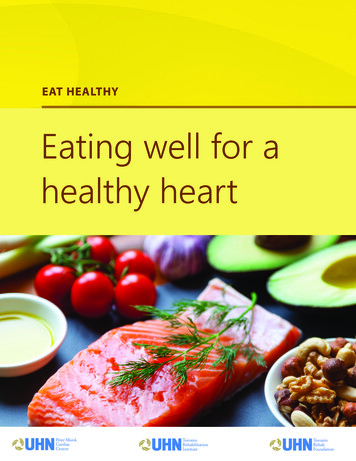
Transcription
EAT HEALTHYEating well for ahealthy heart
Cardiovascular Prevention & Rehabilitation ProgramDr. Paul Oh, Medical DirectorNicole Sandison, Advanced Practice LeaderValerie Skeffington, Program ManagerCrystal Aultman, Project Manager, Health e-UniversityGabriela Melo Ghisi, Scientific AssociateAuthorsKerseri Scane, R. Kin, MSc, BPHENicole Sandison, R. Kin, MSc, HBSc HKSylvia Maksymiu, BPHEFatim Ajwani, RD, BScRegan Leader, MSW, RSWJaan Reitav, Ph. D., C. Psych, CBSMMaria Ricupero, R.D., CDE, MHScDr. Rajni Nijhawan, MDDiane Nixon, RNContributionsKelly Angevaare, R. Kin, MScCrystal Aultman, R.Kin, MSc., OCTMargaret Brum, R.D., CDE, BA ScTracey Colella, IA, ACNP, PhDDaryl Dooks, BScEvelyn Foster, R. Kin, BPHEJoan Kitchen, R. Kin, BSc KinSamantha Kobylnik, MSW, RSWRenee Konidis, R. Kin, BAPhyllis Mancini, MAGabriela Melo Ghisi, MSc., PhDDr. Paul Oh, MD, MSc, FRCPC, FACPVeronica Rouse, MAN, R.D., CDEDr. Michael Sarin, MD, MEd, FRCPC, CDEFarrah Schwartz, MA Promotion de la santéEllen Silaj, BSc PTValerie Skeffington, R. Kin, BPHEPlain Language (2016)Crystal Aultman, R.Kin, MSc., OCTTina Papadakos, MA(Ed)GraphicsKristin FosterAdam LatunsPatients and FamiliesWe would like to thank all of our patients and families who contributed their time and efforttowards the development and evaluation of this workbook. A special thank you goes to JenniferCarling for her dedication and significant contributions to this workbook. Our program and ourpatients appreciate the numerous hours she spent doing clear design and editing.
Eating Well for a Healthy HeartFor people living with heart disease and their caregiversRead this booklet to know: What a heart-healthy diet is Why it is important to eat a heart-healthy diet How to make healthy food choices every day
Table of ContentsEating the Mediterranean Way. 1What it is.1How to eat the Mediterranean way.2Sample menu.9Choosing Healthy Fats.11What is fat. 11Choose more unsaturated fats. 12Choose less saturated fat. 14Choose less trans fat. 14Choosing More Fibre.17What is fibre. 17Soluble fibre. 18Insoluble fibre. 19How to eat more fibre. 20Fibre chart. 22Sample menu. 26Cooking tips for legumes. 28Choosing Less Added Sugars.31Sugar chart. 34Choosing Less Sodium.39How to eat less sodium. 39Sodium chart. 41Sodium content in some restaurant foods. 47Keeping Healthy Triglyceride Levels.49Eating Well for a Healthy Heart
Keeping Healthy Cholesterol Levels.53Keeping a Healthy Blood Pressure.55How to Read a Food Label.59List of ingredients. 59Nutrition Facts Table. 59Serving Size. 60Sodium. 60Fibre. 60% Daily Value. 60Nutrition Claims. 62Cholesterol Free/No Cholesterol. 62Low Fat. 62No Sugar Added. 63Light. 63Know Your Serving Sizes.65Fruits and vegetables. 65Grain products. 65Milk and alternatives. 65Oils and fats. 65Track What You are Eating and Drinking.67Example: My daily food diary. 68My daily food diary. 69Where to Learn More.73Eat Healthy
Eating the Mediterranean WayWhat it isWhat is the Mediterranean way?There are powerful health benefits to eating in the traditional way of peopleliving around the Mediterranean Sea. This includes eating healthy foods,enjoying meals with others and having an active lifestyle.How will this help my heart?Eating the Mediterranean way can: Help control your blood pressure, blood cholesterol and blood sugars Lower your chance of developing health problems including heartdisease, stroke, diabetes, and some cancers Lower your chance of having another heart attackEating the Mediterranean way includes: Lots of foods from plants (fruits, vegetables, whole grains and legumes)Eating fish and seafood more oftenChoosing healthy fats such as olive oil, nuts, and seeds regularlyHaving dairy, poultry, and eggs in moderationHaving very little red meat (beef, pork, lamb) and sweetsEating Well for a Healthy Heart1
Eating the Mediterranean WayHow to eat the Mediterranean wayHow do I eat the Mediterranean way?There is no right way to do this. You can choose foods that you like, usingthe pyramid as your guide (shown in the next image). Everyday foods andactivities are at the base of the pyramid, along with olive oil. Foods closer tothe top should be chosen less often.The 11 steps to eating the Mediterranean way:1. Cook at home more often Use fresh, whole food ingredients to make your favorite dishes Avoid processed or prepared foods Eat out or get take out less often2Eat Healthy
Eating the Mediterranean Way2. Eat fruits and vegetables every day Fruits and vegetables are packed with heart healthy nutrients likevitamins, minerals, fibre and antioxidants. Antioxidants protect the cellsin your body from damage that could lead to health problems Eat a variety of fruits and vegetables every day to lower your risk of heartattack, stroke and some cancersTip: Fill half your plate with vegetables at lunch and dinner.How much a day?What is a serving?Fruits3 or more servings1 medium fruit½ cup fruitVegetables5 or more servings½ cup cooked, raw orfrozen vegetables1 cup leafy greensEating Well for a Healthy Heart3
Eating the Mediterranean Way3. Choose whole grains regularly Whole grains contain insoluble fibre that keeps your bowels regular andmakes you feel full. Some whole grains also contain soluble fibre thathelps lower cholesterol and manage blood sugarTips: Choose a whole grain cereal like oatmeal for breakfast, instead ofprocessed cereals. At main meals, fill at least ¼ of your plate with wholegrains.Whole grainsOne portion is:½ cup barley, farro, quinoa, bulgur, buckwheat,brown, or wild rice, freekeh¾ cup cooked oatmeal (large flake or steel cut)½ cup whole grain pasta1 slice 100% whole grain bread½ small whole grain pita or tortilla4. Have legumes at least 3 times a week Legumes are rich in fibre, vitamins, minerals and protein Legumes contain soluble fibre that helps lower cholesterol and controlblood sugar Legumes can help control blood pressure because they are high innutrients like magnesium and potassiumTips: Use legumes as an alternative to meat. Sprinkle them on salads,add them to soups or enjoy them as a healthy snack.4Eat Healthy
Eating the Mediterranean WayLegumesBeans, split peas, lentils, chickpeas, soybeans (tofu,tempeh and edamame)One portion is: ¾ cup cooked legumes5. Include healthy fats with all meals Extra virgin olive oil is a high quality, healthy oil. Use extra virgin olive oilevery dayTips: Dip whole grain bread into olive oil, instead of using butter. Brushfish or vegetables with olive oil before broiling or grilling.Healthy fats6. Enjoy nuts each week Nuts are a source of healthy fats. Eating them regularly can help lowercholesterol Eating one portion of nuts 3 or more times a week (as part of eating theMediterranean way) can lower the risk of heart events in people at riskEating Well for a Healthy Heart5
Eating the Mediterranean WayNutsPortion size is important because nuts contain a lotof energy (calories).One portion is:1 oz dry roasted, raw, or unsalted nuts (This isabout ¼ cup or a small handful)2 tablespoons of all natural nut butter (such aspeanut or almond butter). Choose ones that are‘100% nuts’ with no other ingredients.7. Choose fish and seafood at least 3 times a week Fish and seafood contain healthy fats, which help prevent heart disease Choose fatty fish such as tuna, salmon, herring and sardines Choose seafood such as clams, scallops, oysters and musselsFish and SeafoodChoose fresh, frozen or canned.Choose canned fish or seafood that is packed inwater and labelled ‘low sodium’.One portion is: 3 to 4 oz This is about the size of adeck of cards6Eat Healthy
Eating the Mediterranean Way8. Have 2 to 3 servings of milk or alternatives each day Milk products (such as milk, yogurt and cheese) and alternatives (suchas soy beverage) contain calcium, vitamin D and protein that keep boneshealthy. And can also help to lower or manage blood pressureMilk and alternativesOne portion is:1 cup (8 oz/250 mL) of milk, or soy milk¾ cup plain kefir, yogurt, ricotta or cottagecheese1.5 oz part-skim cheese with 15 to 20% milk fat(MF)9. Choose meat in moderation Plan your meals around foods from plants (such as vegetables, wholegrains and legumes) instead of meat Use meat and poultry (chicken, turkey or duck) weekly, in moderation, toadd flavour to vegetable dishesWhen you do eat meatChoose poultry more often than red meat(beef, pork and lamb).Avoid processed meats such as sausages,bacon and deli meats.One portion is: 3 to 4 oz This is about the sizeof a deck of cards.Eating Well for a Healthy Heart7
Eating the Mediterranean Way10. Flavour foods with tomatoes, garlic and onion at least 2 times a week This sauce is used to flavour fish, chicken, pasta, vegetable and ricedishes. This sauce is an important part of eating the Mediterranean way becauseit is high in antioxidants. Antioxidants protect the cells of your body fromdamage that could lead to health problems To make this sauce, sauté tomatoes, garlic and onions (or leeks) in a littleolive oil11. Eat less salt (sodium) Flavour foods with herbs and spices instead of salt. Use little or no saltwhen cooking. Do not add salt at the table Use store-bought sauces and processed foods less often Eat out less often. When you do eat at a restaurant, ask for food to beprepared without salt or have sauces and dressings on the sideChoosing foods low insodiumCheck the label! Choose products marked:‘Low in sodium’‘No salt added’‘%Daily Value’ of sodium is 5% or less8Eat Healthy
Eating the Mediterranean WaySample menuBreakfastPlain oatmeal (large flake or steel cut) with ½ cup berries and ¾ cup plainGreek yogurtMorning snack1 medium fruit and1 oz (or small handful) unsalted mixed nutsLunchBean pasta: ¾ cup mixed beans, wholegrain pasta, vegetables, extra virginolive oil and fresh herbsSide salad: 1/8 avocado, ½ tomato, ½ cucumber drizzled in extra virgin oliveoil and fresh herbs and lemon or balsamic vinegar.Afternoon snackChickpea dip (hummus) with1 cup sliced red and yellow peppersDinnerFish dish: 4 oz fish cooked in tomato, garlic and onion sauce with wild riceSide salad: 2 cups green salad with, 1 oz feta cheese, extra virgin olive oil, andfresh herbs with lemon or vinegar.Dessert1 medium fresh fruit or ¼ cup dried fruitEating Well for a Healthy Heart9
Choosing Healthy FatsWhat is fatWhat are fats?There are different types of fatsin food. Having fat in your diet isimportant for your health. You caninclude fat in your diet and stillhave a healthy heart. Some fatsare healthy for you and some arenot. The type of fat you eat is moreimportant than the total amount offat you eat.If certain types of fats (like saturated or trans fats) are eaten often and inlarge amounts they can: Increase your LDL (bad) cholesterol level Make your heart disease worseChoosing foods with healthy fats can lower your LDL (bad) cholesterol levels.What are the different types of fats?There are 3 main types of fat in the foods you eat: Unsaturated fats (oils, plants and fish) Saturated fats (animal foods and tropical oils) Trans fats (commercially prepared, processed foods)Eating Well for a Healthy Heart11
Choosing Healthy FatsChoose more unsaturated fatsWhat is an unsaturated fat?Unsaturated fats are known as “healthy”fats. They may also be referred to asmonounsaturated and polyunsaturated fats.Examples of foods with unsaturated fats are: All oils such as: olive oil, canola oil,peanut oil, sesame oil, corn oil and sunflower oil Olives Peanuts and natural or organic peanut butter Avocado All nuts such as: almonds, cashews, hazelnuts, pecans, and pistachiosTip: To eat more unsaturated fats, use olive oil or canola oil for cooking.Unsaturated fats lower your LDL (bad) cholesterol and can reduce your riskof heart attack and stroke. Unsaturated fats are mostly found in the oils ofplants and fish.What is an omega-3 fat?Omega-3 fats are a type of unsaturated fat. They are found in both plantsand fish.Omega-3 fats can lower your triglyceride (a type of fat in your blood) levels.High triglyceride levels increase the chance that you will have a heart attackor stroke. This means you can reduce the chance that you will have a heartattack or stroke by eating foods with omega-3 fats. You will learn more abouttriglycerides later in this booklet.12Eat Healthy
Choosing Healthy FatsPlant sources of omega-3 fats include: WalnutsGround flaxseed and flaxseed oilHemp hearts and hemp seedsChia seedCanola oilOmega-3 fats are also found in fatty fish.Examples include: TroutHalibutBassSalmonTunaMackerelSardinesHow much unsaturated fat should I eat?Be sure to include unsaturated fats in your diet in moderate amounts.Canada’s Food Guide recommends eating 2 to 3 tablespoons of healthy fatsand oils each day for good health. This includes fats and oils added to foods(such as oil in salad dressing or spreads), as well as oils used for cooking.Eating Well for a Healthy Heart13
Choosing Healthy FatsChoose less saturated fatWhat are saturated fats?Saturated fats are found in all animal productsand tropical oils such as: cocoa butter, palm oil,coconut oil and palm kernel oils. Foods that havehigh levels of saturated fats include marbled orfatty meats and high fat dairy products.Food that is high in saturated fats increases theLDL (bad) cholesterol in your blood.Should I eat less saturated fat?Choose foods with less saturated fats, eat smaller amounts and eat them lessoften. Focus on eating more plant proteins such as, legumes (dried beans,chickpeas, lentils), nut butters, soy products (such as tofu and edamame) andnuts and seeds to make your diet more heart healthy.Choose less trans fatWhat is a trans fat?Trans fats are made when an unsaturated fat(an oil) goes through a chemical process called“partial hydrogenation”. Partial hydrogenationis when food producers add hydrogen atoms(hence the term hydrogenation) to a healthy oil(such as safflower, canola or olive oil). This allowsthe liquid to become a solid and hard fat. Hydrogenation prevents separationof the fat. It can also help with the texture, look and feel of the product andhelp it stay fresh longer.14Eat Healthy
Choosing Healthy FatsPeanut butter is a good example to show hydrogenation. Natural peanut butter needs to be stirred before spreading. The oilseparates from the crushed nuts. Regular (processed) peanut butter does not need to be stirred.Hydrogenation prevents the oil from separatingNatural peanut butter is a better choice because it does not go throughhydrogenation (so it does not contain trans fats).Where are trans fats found?Trans fats are mostly found in prepared, processed foods like store-boughtcookies, pies, muffins and crackers. They are also found in deep friedrestaurant foods such as French fries, sweet potato fries, fried chicken anddonuts.Trans fats increase your LDL (bad) cholesterol and triglyceride levels andlower your HDL (good) cholesterol levels.Should I eat less trans fat?It is best to avoid foods with high levels of trans fats. Trans fats are also calledpartially hydrogenated vegetable oil or shortening. Check the ingredients liston packaged foods for partially hydrogenated or hydrogenated oils/fats orvegetable shortening. This is a clue that trans fats are in the product.Eating Well for a Healthy Heart15
Choosing More FibreWhat is fibreWhat is fibre?Fibre is the part of the plant that your body cannot digestor break down. It is often called “roughage”. Fibre is onlyfound in plant foods.Examples of plant foods include: Vegetables and fruit Whole grains and cereals Legumes Nuts and seedsWhy do I need to eat lots of fibre?Eating fibre helps you manage your health.You should eat a lot of fibre to: Lower your blood sugar Lower your LDL (bad) cholesterol Lower your blood pressureFibre also helps you feel full longer, after a meal. Feeling full longer can helpyou eat the right amount of food for your body (and not too much).As fibre passes through your bowels, it attaches to fat and sugar. This delaysabsorption into your body. The waste is then removed from your body whenyou have a bowel movement (poo). Regular bowel movements (poos) alsokeep your digestive tract healthy.Eating Well for a Healthy Heart17
Choosing More FibreWhat are the different types of fibre?Two types of fibre found in food are: Soluble InsolubleEating plant foods will give you both types of fibre.Soluble fibreWhat is soluble fibre?Foods with soluble fibre absorb water. The watermakes the fibre swell and thicken to form a sticky gel.Soluble fibre can help: Lower your blood cholesterol Manage your blood sugar Manage your blood pressureSome examples of foods that are high in soluble fibre include: 18BarleyOkraEggplantGround flax seedLegumes (beans, split peas, and lentils)OatsAvocadoPectin-rich fruits (apples, pears, berries, and citrus fruits like oranges)Eat Healthy
Choosing More Fibre Psyllium Squash Sweet potato TurnipInsoluble fibreWhat is insoluble fibre?Foods with insoluble fibre do not absorb water.Insoluble fibre: Helps prevent constipation (not able to poo) Keeps your digestive system healthy Prevents some types of cancersInsoluble fibre is found in the bran portion of whole grains and the skins offruit and vegetables.Some examples include: Bran cerealBroccoliBrown riceCabbageCeleryCorn branGreen beansThe skin on kidney beans and other legumesLeafy green vegetablesEating Well for a Healthy Heart19
Choosing More Fibre NutsRaisinsRoot vegetable skinsSeedsWheat bran Whole grains (such as wheat and rye)How to eat more fibreHow much fibre do I need every day?Aim to eat 25 to 50 grams of fibre every day to keep your body healthy andmanage your blood sugar.If you do not eat 25 to 50 grams of fibre every day, you should increase theamount of fibre that you eat to this amount. Increase the amount of fibre you eat slowly, over time. This will helpprevent gas and bloating. As you eat more fibre, make sure you drink more water. This will help thefibre work better. It will also help prevent gas and bloating.Use the charts and tips in the next section to help you eat more fibre.How can I eat more fibre?There are many ways to eat more fibre. Below are tips on how to increase theamount of fibre you eat: Start your day with a cereal that is high in fibre. Try steel cut oats, Branbuds or Fibre 1 cereal20Eat Healthy
Choosing More Fibre Add foods that are high in fibre to your cereal and yogurt. These foodsinclude:– Fruit– Nuts– Ground flax seeds– Chia seeds– Psyllium – Oat branAdd high fibre foods (like the ones listed above) to recipes when youcook or bakePlan your meals and snacks to always include fresh or frozen fruit andvegetablesAim to fill half your plate with vegetables. The more colour on your plate,the more fibre and the more nutrition you getAdd other foods that are high in fibre to meals. For example, addlegumes, such as beans, dried split peas, chickpeas, or lentils. Try addingkidney beans or chickpeas to salads or rice dishes. Put lentils or blackbeans in soups. Include a bean salad as a side dish. To learn more abouthow to include beans/lentils in your diet please refer to the followingpages, “Cooking Tips for Legumes.”Eating Well for a Healthy Heart21
Choosing More FibreFibre chartThe next table is a list of plant foods and the amount of fibre each onecontains. Use this table to help increase the amount of fibre you eat. Recallthat you should eat 25 to 50 grams of fibre every day.FoodServing SizeTotal Fibre (g)Artichoke, cookedmedium4.7Asparagus, cooked6 spears1.8Beans, snap (Italian, green or yellow)cooked125 mL (½ cup)2.1Beets, skinless125 mL (½ cup)1.8Broccoli, cooked125 mL (½ cup)2.0Brussels sprouts, cooked125 mL (½ cup)3.0Carrots, cooked125 mL (½ cup)2.21 medium1.5Collard greens, cooked125 mL (½ cup)4.0Corn, yellow on or off the cob, cooked125 mL (½ cup)2.1Eggplant, cooked125 mL (½ cup)1.3Kale, cooked125 mL (½ cup)1.4Okra, cooked125 mL (½ cup)2.1Peas, green, cooked125 mL (½ cup)5.6Pepper, green or redmedium1.1Potato, white, with skin, baked1 small2.9Rapini, cooked½ cup1.8VegetablesCarrot, raw22Eat Healthy
Choosing More FibreFoodServing SizeTotal Fibre (g)Spinach, cooked½ cup2.3Spinach, raw1 cup0.7Sweet Potato, cooked, skinless125 mL (½ cup)small3.52Squash, cooked125 mL (½ cup)1.3Turnip, cooked125 mL (½ cup)1.61 medium3.532.160 mL (¼ cup)1.7Avocado½ fruit6.7Banana1 medium2.1Blueberries125 ml (½ cup)2.0Figs, dried21.6Fig, fresh22.9½ fruit1.7Nectarine, raw with skin1 medium2.3Orange1 medium2.3Peach, raw with skin1 medium2.9Pear, with skin1 medium5.3125 mL (½ cup)1.232.11 medium1.1Vegetables (continued)FruitApple with skinApricots, raw, with skinApricots, driedMangoPineapplePrunes, driedPlum, with skinEating Well for a Healthy Heart23
Choosing More FibreFoodServing SizeTotal Fibre (g)Raspberries125 mL (½ cup)4.2Strawberries125 mL (½ cup)2.030 g (⅓ cup)11.2125 mL (½ cup)2.030 g (1 slice)2.1125 mL (½ cup)2.0Bread, rye35 g (1 slice)1.4Bran cereal (non flake)30 g (½ cup)9.7Crisp bread crackers3 crackers5.0Melba toast, whole wheat4 crackers1.5Oat bran, cooked175 mL (¾ cup)5.9Oatmeal, cooked175 g (¾ cup)3.730 g (1 cup)3.2Pasta , cooked (whole wheat)125 mL (½ cup)2.1Quinoa, cooked125 mL (½ cup)2.7Almonds60 mL (¼ cup)3.8Black beans, cooked250 mL (1 cup)12.7Chickpeas, cooked250 mL (1 cup)7.933 g (¼ cup)1.0125 mL (½ cup)4.0Fruit (continued)Grains & CerealsBran Buds (with Psyllium)Barley, pearled, cookedBread, whole grainBrown rice, medium grain, cookedCheerios Meat Alternatives- Plant ProteinsCashewsEdamame, (soybean, green,cooked)24Eat Healthy
Choosing More FibreFoodServing SizeTotal Fibre (g)Meat Alternatives - Plant Proteins (continued)Flax seed (linseed), ground15 ml (1 Tbsp)1.9Kidney beans, cooked250 mL (1 cup)12.3Lentils, cooked250 mL (1 cup)8.9Lima Beans250 mL (1 cup)9.5Soybean, cooked250 mL (1 cup)11.4Sunflower seeds, dry roasted60 mL (¼ cup)3.6Tofu, fried pieces150 g (¾ cup)5.8Peanuts60 mL(¼ cup)3.1Source: “Canadian Nutrient File 2015.” -data/cnf downloads-telechargement fcen-eng.php[Accessed May 31, 2017]Eating Well for a Healthy Heart25
Choosing More FibreSample menuHere is a sample day’s menu showing how to eat enough fibre (25 to 50 grams)in one day:BreakfastAmount ofFibre (g)Oatmeal, cooked 175 g (¾ cup)3.7Blueberries, ½ cup2.0Soy beverage or skim milk, 1 cup0Almonds, ¼ cup3.8Flax seed (linseed), ground, 1 tablespoon1.9Breakfast Total11.4LunchSpinach salad, 3 cups2.1Chickpeas, canned, low sodium, 1 cup7.9Cherry tomatoes, 151.5Banana2.1Whole grain bread, 1 slice2.1Homemade dressing, olive oil and balsamic vinegar0Water0Lunch Total2615.7Eat Healthy
Choosing More FibreDinnerGrilled salmon, 4 oz (120 g)Amount ofFibre (g)0Rapini, cooked, 1 cup3.7Carrots, cooked, ½ cup2.2Quinoa, cooked, 1 cups5.4Water0Dinner Total11.4Total fibre for the day38.4Eating Well for a Healthy Heart27
Choosing More FibreCooking tips for legumesLegumes refer to the plants whose fruit is enclosed in a pod, which includepulses, beans and lentils. “Pulses” refer to dried seeds (not fresh beans orpeas). Soybeans and peanuts are different from pulses because they havemore fat.LegumesSoybeansPeanutsPulsesDried beansDried peasChick peasLentilsFresh beansFresh peasStep 1: Buying and storing legumes/beans28Canned Legumes/BeansDried Legumes/BeansConvenient and ready-to-use (nosoaking required).Need time to prepare.Look for “Low Sodium” or “No SaltAdded” options.Found in bulk stores or in grocerystores (usually packaged in clear bagsand found beside canned beans).Thoroughly rinse and drain cannedpulses to reduce your sodium intake.Store in a container with a tight lid, in acool, dark place.Eat Healthy
Choosing More FibreStorage: Enjoy your legumes/beans within a year of buying them. Store yourcooked legumes/beans in the fridge for 1-3 days or in the freezer for severalmonths.Step 2: Rinsing and Soaking Dry Legumes/Beans1. Rinse all dried legumes, beans and lentils before soaking2. Discard soaking water and rinse beans with cold water. Rinsing will helpwash away the part of the bean that causes gasWhich legumes, beans or lentils need to be soaked before cooking?Soaking requiredNo soaking required (just rinse)Dry beans, whole peas, chickpeasDry lentils, split peasStep 3: Cooking Dry PulsesCook dry legumes, beans and lentils using the stove, microwave, slow cookeror pressure cookerUse 3 cups (750 mL) of water for every 1 cup (250 mL) of soaked beansFor the stove-top method:1. In a pot, combine soaked beans and water. Boil the water.2. Reduce heat and simmer.3. To check for readiness, taste the bean for desired firmness.Eating Well for a Healthy Heart29
Choosing More FibreLegumes, Beans, LentilsCooking TimeBeans45-60 minutesPeasWhole1 – 1 ½ hoursSplit40 – 45 minutesLentilsWhole green30 – 45 minutesSplit red10 – 15 minutesChickpeas1 – 1 ½ hour(Pulse Canada, 2012)30Eat Healthy
Choosing Less Added SugarsWhat is added sugar?The American Heart Association defines “added sugars” as the sugars andsyrups added to foods during the processing or preparation. The sugars andsyrups that are added at the table are also added sugars.Sugars that are locked in and naturally found in foods such as fruit,vegetables, milk and whole grains are healthy choices. These foods arerecommended as part of a healthy diet.Why is added sugar bad for my heart?High sugar intake from added sugars is linked to high triglyceride levels. Hightriglyceride levels in your blood incr
in food. Having fat in your diet is important for your health. You can include fat in your diet and still have a healthy heart. Some fats are healthy for you and some are not. The type of fat you eat is more important than the total amount of fat you eat. If certain types of f

